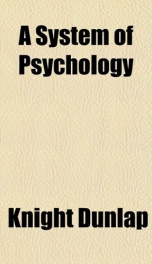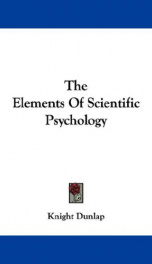a system of psychology

Purchase of this book includes free trial access to www.million-books.com where you can read more than a million books for free. This is an OCR edition with typos. Excerpt from book: CHAPTER III SENSATION IN GENERAL I. Sensation, Physical Stimulus, and Physiological Process Sensationthat which is experienced through the senses, or through sensemust be distinguished rigidly from the physical stimulus, on the one hand, and the nervous activity which is caused by this stimulus, on the other hand. The normal stimulus is some activity of what we call "matter," usually outside of, but acting on, the body of the individual. Thus, the oscillation of the air particles which act on the inner organs of the ear and produce sound; the vibration of the ether which stimulates the retina of the eye and occasions the experience of light; the chemical activity of substances, which produces odor; these are instances of stimuli. There is little difficulty in distinguishing stimuli from sensations, even for the beginner, for a little reflection convinces us that these physical facts are not experienced, but only inferred. When, for instance, I hear a tone, I am not conscious of the back-and-forth movement of the air particles; and when I see acolor I am not experiencing the undulations of the ether. In the latter case the stimulus is so far from being experienced that it has required great labor to discover its real nature (assuming that we do know it now) by inferences from observations, and it took years for those who held the present theory to convince of error those who drew different conclusions from the observations. Even to-day physicists do not profess to have a complete understanding of the actual behavior of the ether and some of them doubt its existence. Yet an ignorant man, who has never heard of ether, and whose views on the transmission of light are amusing, may experience light and color sensations which are as highly developed as those of any one. Th...
Info about the book
Author:
Series:
Unknown
ISBN:
0805809279
Rating:
3/5 (4)Your rating:
0/5
Languge:
English
Users who have this book
Users who want this book
What readers are saying
What do you think? Write your own comment on this book!
write a commentif you like a system of psychology try:
Do you want to read a book that interests you? It’s EASY!
Create an account and send a request for reading to other users on the Webpage of the book!




